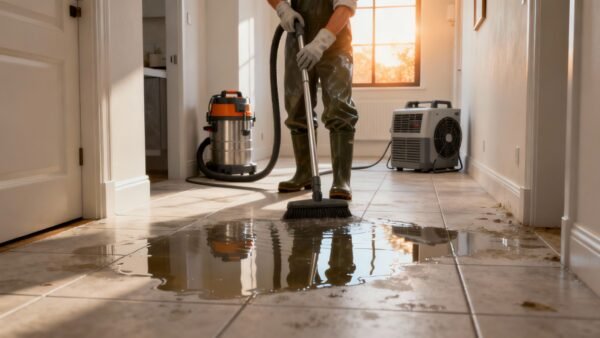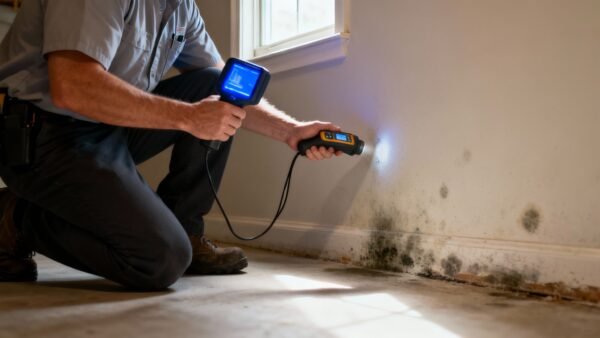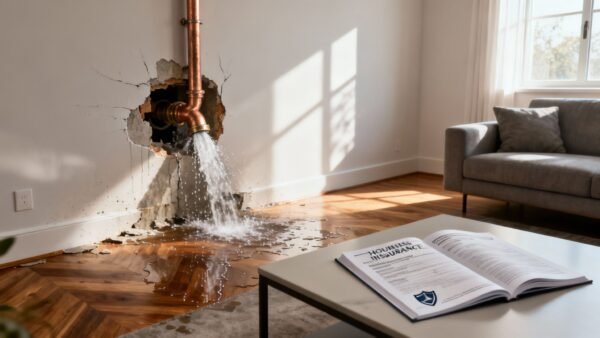That musty smell in your basement you can't quite place, or that dark spot spreading on the ceiling after a long winter in Los Angeles? That’s not just an annoyance—it's your house sending up a flare. Searching for "mold inspection services near me" is the essential first step to protect your property and, more importantly, your family's health. A professional mold inspection is like a health check-up for your home, diagnosing serious issues that are often impossible to spot on your own.
If you suspect mold, don't wait. An unbiased assessment is crucial for creating a safe and effective removal plan.
Get a Free Mold Inspection
The Hidden Dangers of Indoor Mold
Ignoring the signs of mold is like ignoring a check engine light. The problem almost never goes away on its own; it just gets worse. While you might be tempted to just clean a small visible spot, what you see is often just the tip of the iceberg. The real damage comes from the massive colonies of spores that thrive hidden from view, especially in places like a damp Sherman Oaks crawlspace or behind a poorly sealed window in Santa Monica.
A persistent musty odor is one of the biggest red flags for hidden growth. In fact, addressing a persistent musty smell in your home is often the first clue that a professional inspection is needed. These unseen colonies are where the real risks to your health and property value are lurking.
Common Triggers for Mold Growth in Southern California Homes
Mold needs one thing above all else: moisture. An inspection becomes absolutely critical after any event that introduces excess water into your home's structure. Look out for these common triggers:
- Recent Water Damage: A burst pipe, a leaky appliance, or a flood creates the perfect breeding ground. Mold can take hold in as little as 24-48 hours.
- High Humidity: Areas with poor ventilation, like bathrooms, basements, and attics, can trap moisture, leading to chronic dampness and widespread mold.
- Visible Signs or Odors: If you can see discoloration or smell that tell-tale earthy odor, an inspection is needed to figure out just how far the problem has spread.
More and more homeowners are recognizing these dangers. The market for mold detection services is expected to hit $4.2 billion by 2033, driven by growing concerns over health issues like allergies and asthma. You can learn more about how we go about detecting hidden mold behind walls to get a better sense of why a professional eye is so crucial.
What to Expect During a Professional Mold Inspection
When you hire a professional for a mold inspection, you’re not just getting a quick walkthrough. It’s a full-blown investigation aimed at uncovering the root cause of a potential mold problem. The process always starts with a detailed visual assessment of your property, where the inspector is on the hunt for tell-tale signs of moisture, water damage, and any visible mold growth.
But the real value of a professional inspection lies in finding what’s hidden from the naked eye. Mold loves to grow in dark, damp places, and that’s where specialized equipment comes into play.
Uncovering Hidden Moisture
Spotting hidden water is the most critical part of the job. To do this, inspectors rely on a few key tools of the trade:
- Moisture Meters: These devices are the workhorses of any inspection. They measure the moisture content inside materials like drywall and wood, allowing the inspector to pinpoint damp areas that are perfect breeding grounds for mold—even if they look completely dry on the surface.
- Thermal Imaging Cameras: Think of these as high-tech moisture detectives. Infrared cameras show temperature differences on walls, floors, and ceilings. A cold spot might just be a draft, but it could also be a hidden water leak that needs immediate attention.
This infographic breaks down the most common triggers that lead to the kind of moisture problems inspectors are trained to find.
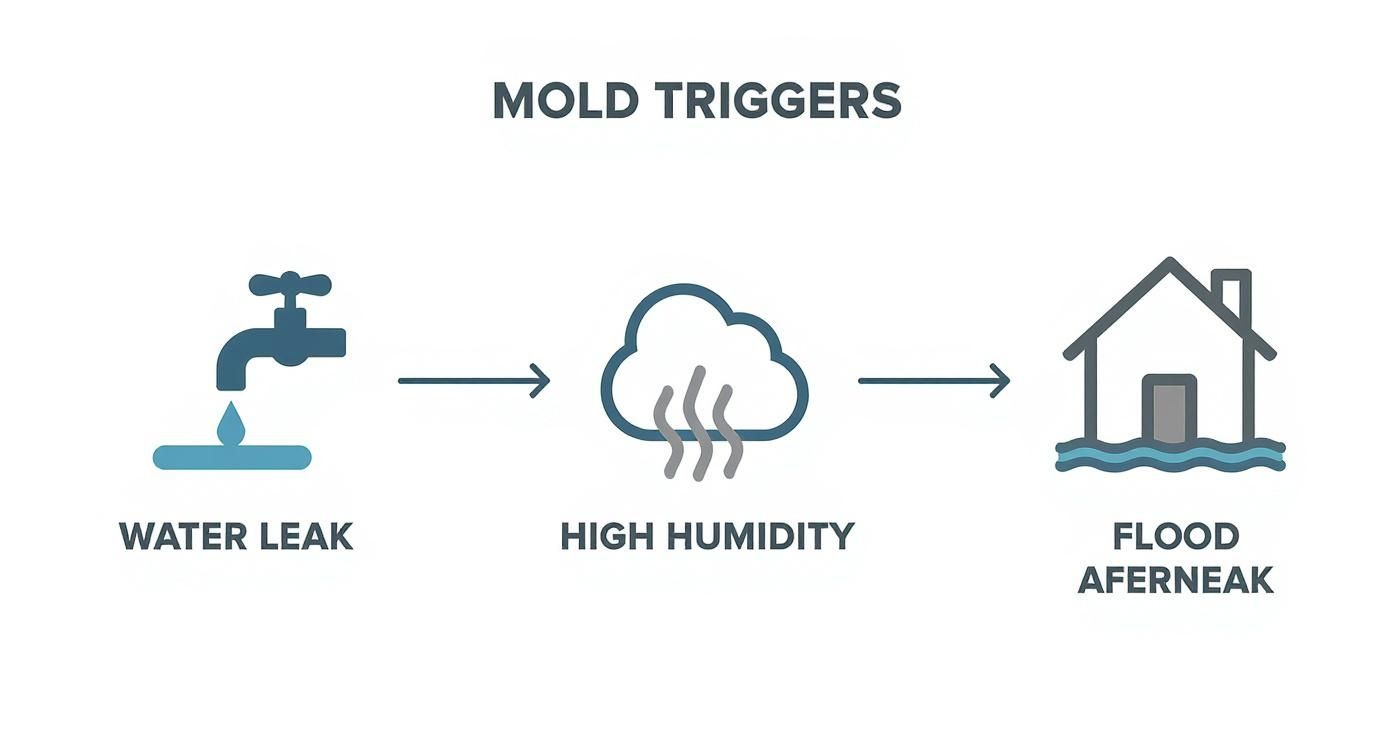
As you can see, something as simple as a slow leak or a humid bathroom can quickly escalate if you don't catch it early.
Collecting Data for Analysis
To truly understand what you’re up against, an inspector often needs more than just visual cues and moisture readings. This is where sampling comes in. They might take air samples to check the concentration of airborne spores or use surface swabs to identify the exact type of mold growing.
These samples provide hard data, turning guesswork into science and giving you a clear picture of your home’s indoor air quality. By combining what they see, what their meters tell them, and what the lab reports, the inspector builds a complete profile of the contamination. Our detailed mold testing services provide exactly this kind of concrete data, which is essential for creating a remediation plan that actually works.
Health Risks Linked to Mold Exposure
That nagging cough or those allergies that just won't quit are often the first push for someone to search for "mold inspection services near me." And for good reason. Mold isn't just an ugly spot on the wall; it pumps microscopic spores into your home's air, and breathing them in can have a direct impact on your health.
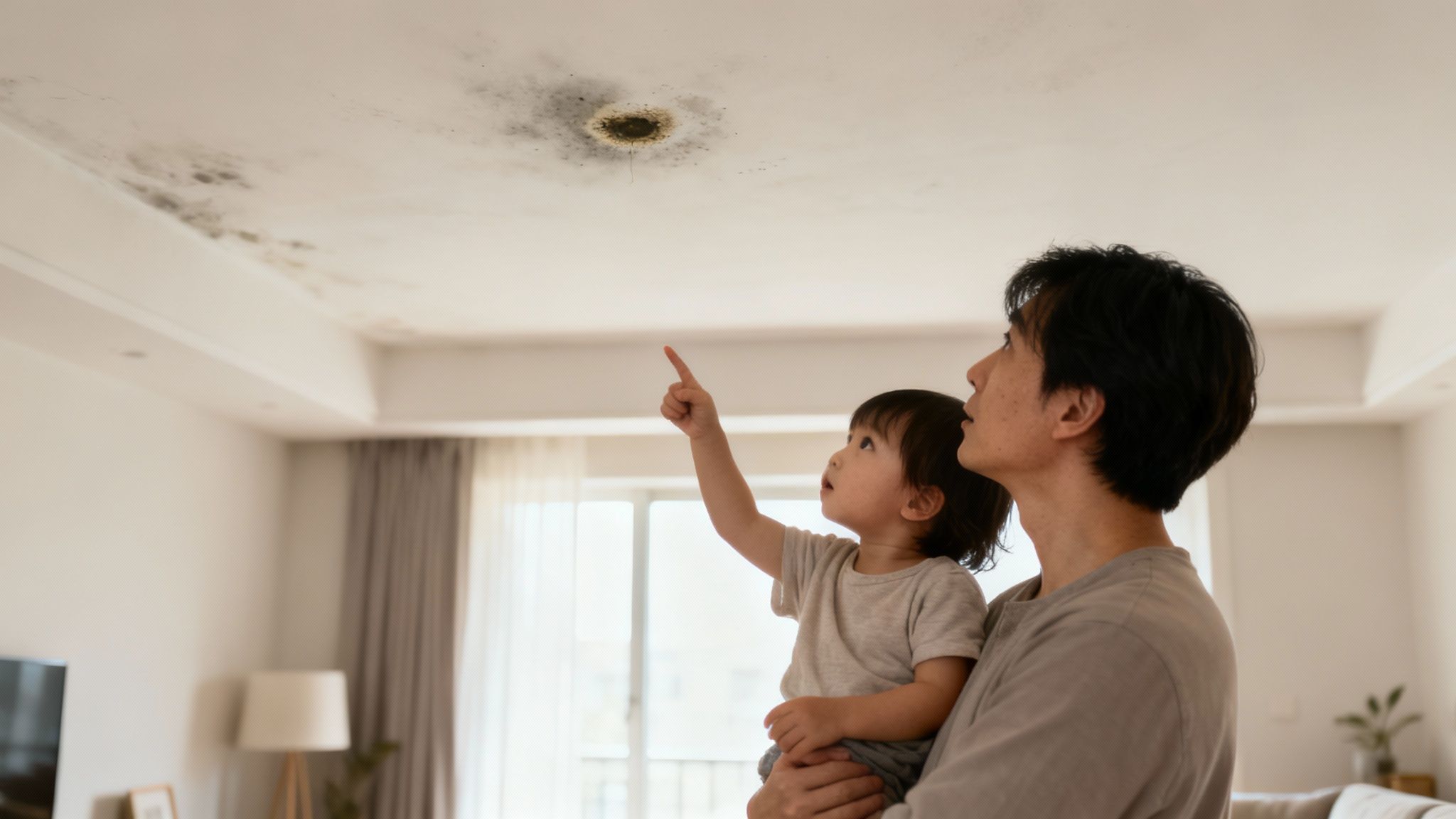
This kind of constant exposure can set off a whole cascade of issues. We’re talking about everything from chronic coughing and sneezing to sinus congestion and skin irritation. For anyone with asthma, these airborne particles are particularly nasty, often triggering more frequent and severe attacks that make it hard to breathe easy at home.
Vulnerable Populations and Mold
While mold can make anyone feel sick, some people are far more vulnerable to its effects. Children, the elderly, and anyone with a compromised immune system are at a much higher risk of developing respiratory infections and other serious health problems.
This isn't just speculation; public health organizations like the Centers for Disease Control and Prevention (CDC) have been warning about these dangers for years, establishing clear links between indoor mold and significant health issues.
Cleaning can help, especially professional services focused on removing allergens and mold from carpets where spores love to hide. But understanding the full health picture makes it clear why acting fast is so important. You can find out more about protecting your home with our expert mold testing and removal near me services.
Choosing the Right Local Mold Inspection Company
Let's be clear: not all mold inspectors are created equal. Choosing the right one is probably the most important step you'll take, because an accurate diagnosis sets the stage for everything that follows. When you start searching for "mold inspection services near me," you need to look past the ads and focus on professionals with solid credentials and a reputation for honest, unbiased work.
Your first move should be to verify their qualifications. Look for certifications from well-respected industry organizations like the IICRC (Institute of Inspection, Cleaning and Restoration Certification). This isn't just a piece of paper; it means they’ve had the proper training to actually identify complex mold issues correctly. And always, always ask for proof of insurance—it’s there to protect you.
Spotting Major Red Flags
A good inspector gives you data, not a high-pressure sales pitch. The single biggest red flag is an inspector who also offers remediation services and immediately tries to sell you on an expensive cleanup job. This is a massive conflict of interest. An independent inspector's only job is to give you the unvarnished truth about what’s going on in your home.
A truly professional inspector works for you. They provide a detailed report that empowers you to make an informed decision, not one that pushes you into a quick sale on a costly remediation job.
When you're talking to potential inspectors, ask them about their process and the tools they use. A legitimate pro will be using equipment like moisture meters and thermal imaging cameras to find the source of the problem. Be extremely wary of anyone offering a "free inspection"—it often feels less like an assessment and more like a setup for a sales call.
For a deeper look into vetting professionals, check out our guide on finding the right mold removal companies near me.
How to Understand Your Mold Inspection Report
After your inspector leaves, you’ll get a detailed report that can feel a bit like a science experiment. Don't be intimidated. This document is the crucial bridge between finding a potential mold problem and actually fixing it, translating all that technical data into a clear plan for your home.
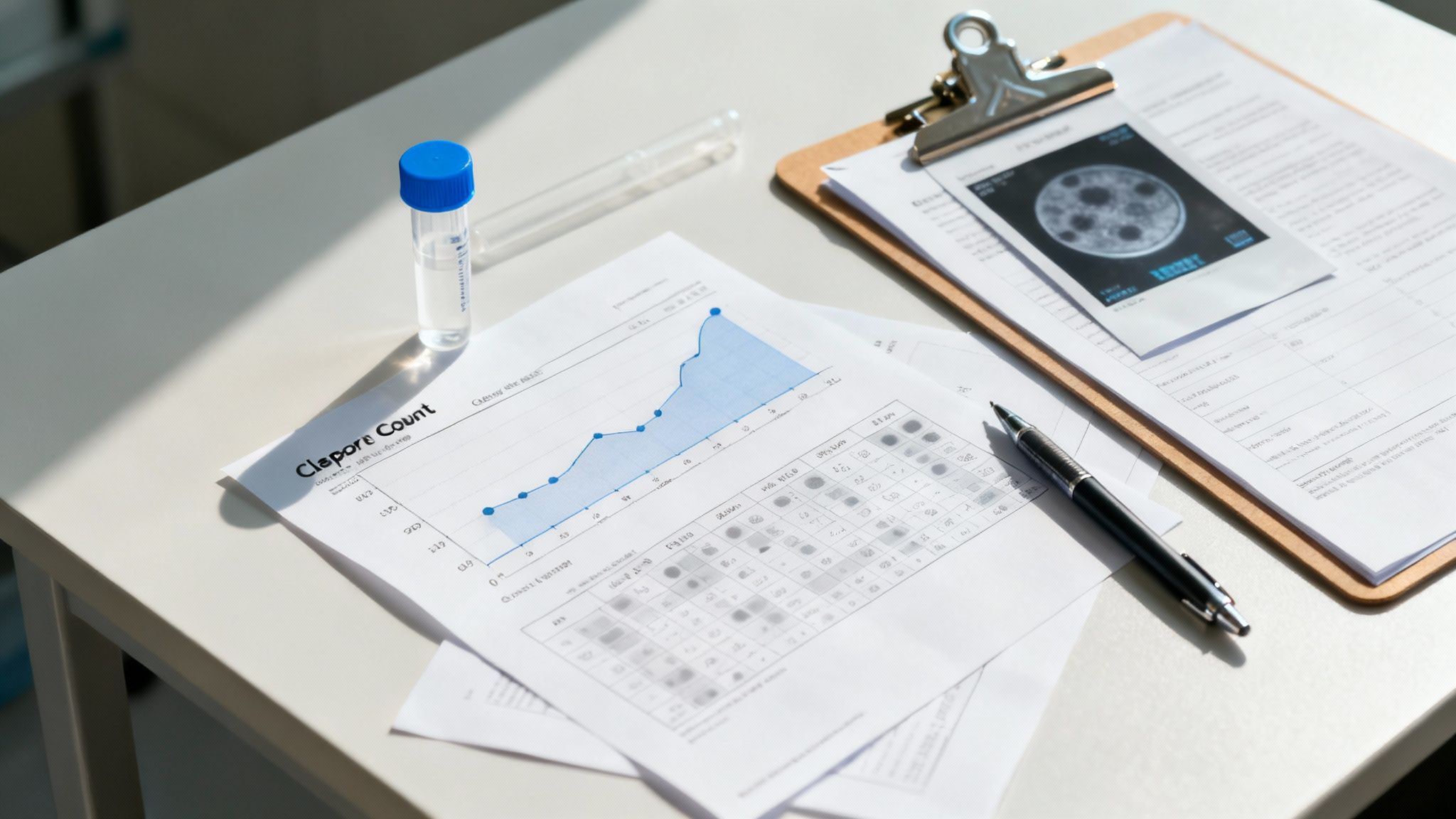
Think of the report as a roadmap, not just a simple pass/fail grade. It will walk you through the inspector’s visual findings, list out moisture readings, and, most importantly, explain the lab results from any samples they collected.
Decoding the Lab Results
The real heart of your report is the laboratory analysis. This section gives you objective, third-party data about what’s really going on in your home's air. Here’s what you need to zero in on:
- Spore Counts: This is the big one. It tells you the concentration of mold spores found in your indoor air. The report will compare your indoor levels to an outdoor "control" sample; if your indoor counts are significantly higher, it’s a strong sign you have an active mold colony growing somewhere inside.
- Species Identification: Not all mold is created equal. The lab identifies the specific types of mold present, like Aspergillus or the notorious Stachybotrys (often called black mold). Knowing the species helps determine potential health risks and how urgently you need to act.
The entire point of the report is to arm you with independent, scientific facts. This data empowers you to make an informed decision about remediation without any guesswork or high-pressure sales tactics.
Based on all this evidence, the report will wrap up with the inspector's specific recommendations. These are the practical next steps you should take to get your home's environment back to a healthy state.
Frequently Asked Questions About Mold Inspections
Here are straightforward answers to the questions we hear most often from homeowners looking for mold inspection services.
Q: Can I just use a DIY mold test kit?
A: It’s tempting, but DIY kits often cause more confusion than clarity. They usually can't tell the difference between normal, everyday spore levels and a genuine indoor contamination problem that needs attention. A professional inspection uses calibrated equipment and accredited labs to get precise, actionable data you can rely on.
Q: How long does a mold inspection take?
A: For an average-sized home, a thorough inspection typically takes between 2 to 4 hours. The final timing really depends on the size and complexity of your property, and whether we need to get into tricky areas like crawl spaces or attics.
Q: What’s the difference between mold inspection and remediation?
A: Think of it as diagnosis versus treatment. An inspection is the investigative phase to identify if mold is present, pinpoint its location, and determine the extent of the problem. Remediation is the action phase—the hands-on process of safely removing the mold, cleaning contaminated surfaces, and fixing the moisture source.
Q: Will my insurance cover a mold inspection?
A: It depends. Insurance coverage for mold can vary wildly from one policy to another. Many standard homeowner policies have strict limitations or exclusions for mold unless the growth was a direct result of a covered event, like a sudden pipe burst. Your best bet is to review your policy or call your agent directly. For more details, check our mold remediation FAQ.
Q: How do I prepare my Los Angeles home for a mold inspection?
A: Close all windows and doors for at least 24 hours beforehand to create stable conditions for air sampling. Also, ensure the inspector has clear access to areas like basements, attics, and under sinks.
Q: What happens if you find mold?
A: The inspector will provide a detailed report outlining the type of mold, the extent of the contamination, and a recommended remediation plan. This report is your roadmap for getting the problem fixed by a qualified abatement professional.
If you're seeing signs of mold or just feel concerned about your home's air quality, don't put it off. Waiting only lets the problem grow.
Contact Onsite Pro Restoration today for a professional, unbiased assessment.
Get a Free Mold Inspection


